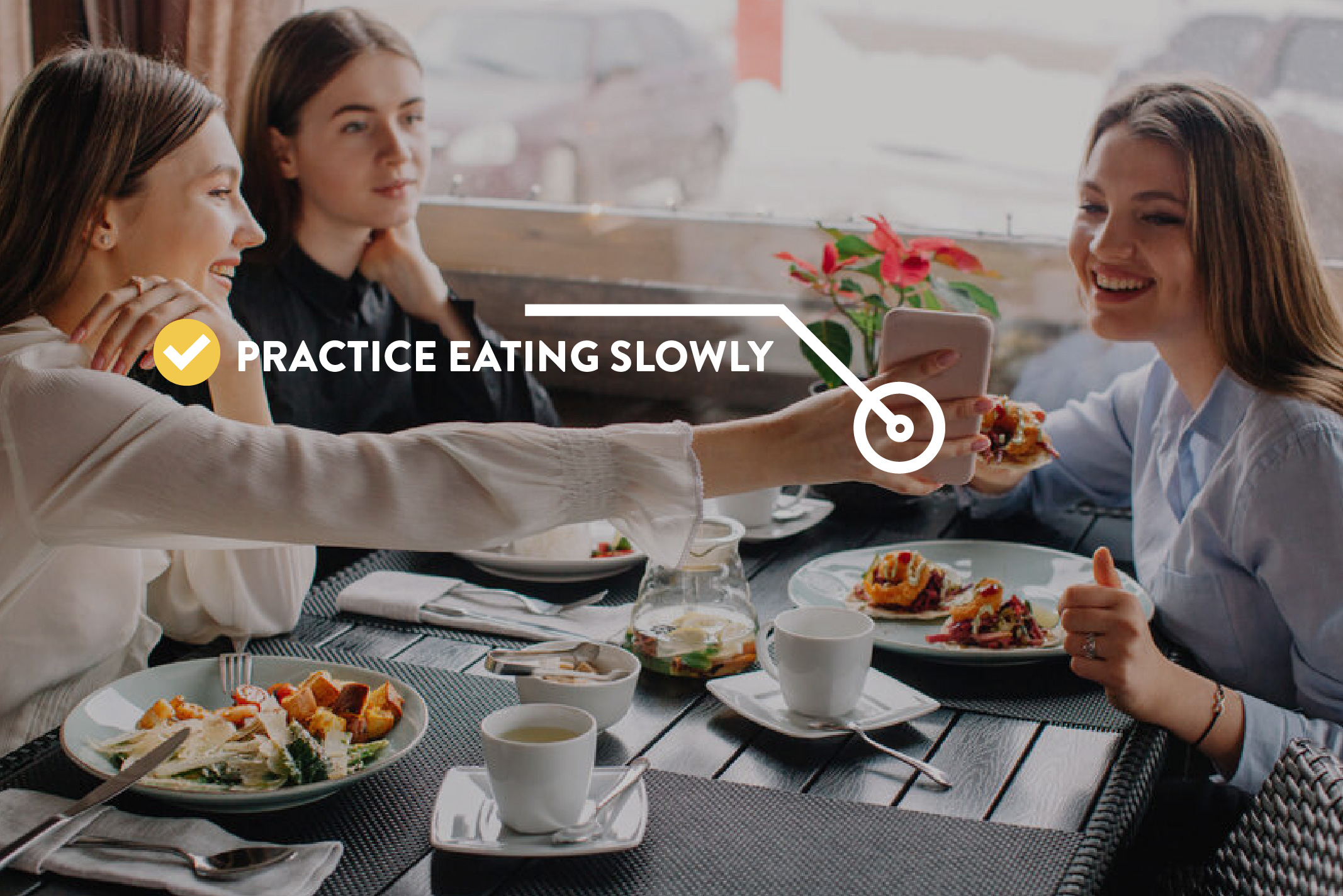Take your time while eating. Slow down. Think about the different flavors you’re tasting. The texture of the food you’re eating. Swallow. Breathe. Put the fork down. Take time to chat with family or loved ones between bites. Sip some water. Notice how hungry you’re feeling. Okay, now take the next bite. Your stomach needs about 20 minutes to decide it’s full and sends the signal to your brain [1]. So rather than blitzing your stomach with food in that time frame, this habit is all about stalling for your slow stomach.
Avoiding overeating
Logically, the benefit of giving your stomach enough time to catch up to what you’ve ingested means you’ll be less likely to overeat. Rather than bingeing and cramming as much food as possible into your stomach and blowing past the point of fullness. Eating slowly allows you to approach the point of fullness and stop as you approach it. Imagine you’re driving and trying to stop at a stop sign. You’re more likely to stop at the line if you’re going fifteen miles an hour, rather than 60. And research supports this. Eating slower can decrease the total number of calories consumed in a meal [2] while also increasing an individual’s perception of fullness [3] [4].
In addition to these findings, it’s been found that eating slowly can be a form of active meditation [5]. Mindfully eating includes any act of drawing presence to eating. For example, think of the flavor, temperature, and texture of the food in your mouth. Sometimes closing your eyes while chewing helps with this, although it’s not necessary. Mindfulness while eating contributes to greater levels of satisfaction with your meal, as well as greater feelings of satiation. Mindful eating helps you lose weight by reducing stress and altering your eating behaviors [6].
Stop and taste the food
There are many ways to slow down eating. One way is to chew your food more thoroughly. This not only extends the time spent eating a meal, but it also assists in digestion and helps you better absorb nutrients [7]! Choosing foods that are high in fiber will not only require you to chew more, but high fiber diets have also been linked to weight loss [8]. Another way to steer clear of eating too quickly is to avoid getting acutely hungry. Once you become ravenous it’s a lot harder to eat at a reasonable pace. To dodge extreme hunger during the day, make sure to have healthy snacks on hand to stave off any encroaching hunger pains.
Help your clients set a difference pace
This habit is optimal for many people, as it is something we all do many times a day. Novice habit builders can use this habit to get a good foundation started in regards to both mindfulness and nutrition. Eating slowly is a great habit to stack with the correct portion size habit, or the eating until 80% full habit. These three habits can potentially overlap and transition from one another, so start with the one your client will be most likely to succeed at. Then add another one to reinforce the habit already established. The challenge with the pacing habit is going to be for the “go-go-go” clients. They often will cite they don’t have time to slow down and enjoy a meal. For this client, aim for the low-hanging fruit. Work with them to identify at least one snack a day they will commit to slowing down while eating.
Trainerize features that can help with this habit are auto messages, and of course the habit tracking feature. Setting auto messages in the calendar to coincide with your clients’ meal times is a great prompt for your clients. Try asking your clients to focus on certain aspects of their eating. For example, putting their utensils down until they’re done chewing, trying to isolate flavors they taste, or simply reminding them to just slow down. Every meal they do this, even for part of the meal, they get to track their habit as complete! Aim to reinforce new habits by following up messages to your phone with a quick direct message through the app congratulating them on a job well done!
Eating slowly in a nutshell:
- Eating slowly in a habitual manner is important to help your stomach-mind connection operate at an optimal pace.
- The mindfulness of eating slowly decreases caloric intake, increases satiation, increases satisfaction, and decreases stress.
- Using this habit to teach the feeling of fullness can be supported with habit tracking and auto messages as reminders.
References:
- https://www.healthline.com/nutrition/eating-slowly-and-weight-loss#eating-slowly
- Shah, Meena et al. Slower Eating Speed Lowers Energy Intake in Normal-Weight but not Overweight/Obese Subjects. Journal of the Academy of Nutrition and Dietetics, Volume 114, Issue 3, 393 – 402
- Andrade, Ana M. et al. (2008). Eating Slowly Led to Decreases in Energy Intake within Meals in Healthy Women. Journal of the American Dietetic Association, Volume 108, Issue 7, 1186 – 1191
- Alexander Kokkinos, Carel W. le Roux, Kleopatra Alexiadou, Nicholas Tentolouris, Royce P. Vincent, Despoina Kyriaki, Despoina Perrea, Mohammad A. Ghatei, Stephen R. Bloom, Nicholas Katsilambros, Eating Slowly Increases the Postprandial Response of the Anorexigenic Gut Hormones, Peptide YY and Glucagon-Like Peptide-1, The Journal of Clinical Endocrinology & Metabolism, Volume 95, Issue 1, 1 January 2010, Pages 333–337, https://doi.org/10.1210/jc.2009-1018
- https://www.healthline.com/nutrition/mindful-eating-guide#what-it-is
- Jennifer Daubenmier, Jean Kristeller, Frederick M. Hecht, et al., “Mindfulness Intervention for Stress Eating to Reduce Cortisol and Abdominal Fat among Overweight and Obese Women: An Exploratory Randomized Controlled Study,” Journal of Obesity, vol. 2011, Article ID 651936, 13 pages, 2011. https://doi.org/10.1155/2011/651936.
- https://www.healthline.com/health/how-many-times-should-you-chew-your-food#benefits
- Veronese N, Solmi M, Caruso MG, et al. Dietary fiber and health outcomes: an umbrella review of systematic reviews and meta-analyses. Am J Clin Nutr. 2018;107(3):436-444. doi:10.1093/ajcn/nqx082

